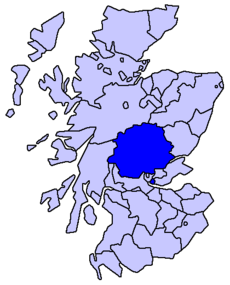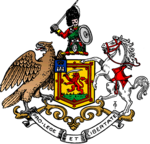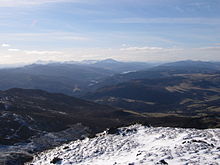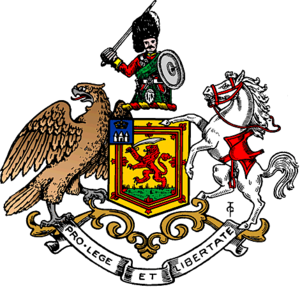- Perthshire
-
Perthshire Motto: Pro Lege et Libertate
('For Law and Liberty')
Perthshire within ScotlandGeography Status Local government county (until 1975)
Land registration county (1996 - )1975 area 2528 sq. miles (6547 sq. km) (5th) HQ Perth (county town and administrative centre) Chapman code PER History Succeeded by Tayside Region Politics Governance County: Perthshire County Council (1890-1929)
Perth and Kinross County Council (1929-1975)
Modern: Perth and Kinross Council (1996 - )
Lieutenancy: Lord Lieutenant of Perth and Kinross
Coat of arms of the county councilPerthshire, officially the County of Perth (Scottish Gaelic: Siorrachd Pheairt), is a registration county in central Scotland. It extends from Strathmore in the east, to the Pass of Drumochter in the north, Rannoch Moor and Ben Lui in the west, and Aberfoyle in the south. It was a local government county from 1890 to 1930.
Perthshire was known as the "big county" and had a wide variety of landscapes, from the rich agricultural straths in the east, to the high mountains of the southern Highlands.
Contents
History
Perthshire was a top-level local government area between 1890 and 1975, governed by a county council. From 1930, a joint county council was formed with the neighbouring small county of Kinross-shire, linking the two.
The county was abolished in 1975 by the Local Government (Scotland) Act 1973 and split between Central and Tayside Regions:
- West Perthshire (the area west and south of Killin including Callander, Crianlarich and Aberfoyle) was included in the Stirling District of Central Region.
- The parish of Muckhart and Glendevon was made part of Clackmannan District, also in Central Region.
- Longforgan was included in the City of Dundee District, in Tayside Region.
- The remainder of the county was combined with the county of Kinross and the Angus parish of Kettins to form Perth and Kinross District in Tayside.
The two-tier system introduced in 1975 was replaced by a system of unitary authorities in 1996. The area of the former county is now divided between the council areas of Clackmannanshire, Perth and Kinross and Stirling. The area included in Dundee in 1975 was transferred to Perth and Kinross.
The Perthshire county boundary is still used for the purposes of land registration. Perthshire extended to 5300 km².
Boundaries
Prior to the 1890s Perthshire's boundaries were irregular: the parishes of Culross and Tulliallan formed an exclave some miles away from the rest of the county, on the boundaries of Clackmannanshire and Fife; while the northern part of the parish of Logie formed an enclave of Stirlingshire within the county. Following the recommendations of the boundary commission appointed under the Local Government (Scotland) Act 1889, Culross and Tulliallan were transferred to Fife, and the entire parish of Logie was included in Stirlingshire.
Coat of arms
The coat of arms of the County of Perth appears to have been granted for use on the colours and standards of the volunteer and militia units of the county raised at the end of the eighteenth century. Robert Hay Drummond, a native of Perthshire, and commanding officer of the Perthshire Gentlemen and Yeomanry Cavalry, was also Lord Lyon King of Arms at the time, and he presented the arms to the county in 1800.
The shield is clearly based on the royal arms of Scotland. The red lion was made to stand on a grassy mound and brandish a scimitar, probably symbolising defence of the county. A blue canton in the top left of the arms depicted the Palace of Scone ensigned by an imperial crown.
The crest was a highland warrior, holding a broadsword "aloft in a menacing posture". The depiction of the highlander differed over time: the illustration here is from the turn of the twentieth century and shows the full dress uniform of an officer of a British army highland regiment.
The supporters were an eagle and a white war horse. The eagle was taken from the arms of the Royal Burgh of Perth. The war horse may refer to the military use of the arms.
The Latin motto was Pro Lege et Libertate or For Law and Liberty, and was similar to that of Perth.
The grant document was discovered in the Lyon Office in 1890, and forwarded to the newly formed Perth County Council.
Subdivisions
Burghs
By the 1890s the county contained the following burghs, which were largely outside the county council's jurisdiction:
- Royal Burgh of Perth (which was styled a city)
- Burgh of Auchterarder (formed 1894: reinstated as a royal burgh in 1951)
- Burgh of Aberfeldy (police burgh from 1887)
- Burgh of Abernethy (burgh of barony from 1458/9, police burgh from 1877)
- Burgh of Alyth (police burgh 1834)
- Burgh of Blairgowrie (burgh of barony 1634, police burgh 1833)
- Burgh of Rattray (police burgh 1873)
- Burgh of Callander (police burgh 1866)
- Burgh of Coupar Angus (burgh of barony 1607, police burgh 1852)
- Burgh of Crieff (burgh of barony 1674, burgh of regality 1687, police burgh 1864)
- Burgh of Doune (burgh of barony 1611, police burgh 1890)
- Burgh of Dunblane (burgh of regality of the Bishop of Dunblane 1442, police burgh 1870)
The Local Government (Scotland) Act 1929 divided burghs into two classes from 1930: large burghs, which were to gain extra powers from the county council, and small burghs which lost many of their responsibilities. Of the twelve burghs in Perthshire, only Perth was made a large burgh. There were ten small burghs: Blairgowrie and Rattray being united into a single burgh.
In 1947 Pitlochry was created a small burgh.
Civil parishes
Following the boundary changes caused by the Local Government (Scotland) Act 1889, the county contained the following civil parishes:
- Aberdaugie
- Aberfeldy
- Aberfoyle
- Abernethy
- Abernyte
- Alyth
- Ardoch
- Arngask
- Auchterarder
- Auchtergaven
- Balquhidder
- Bankfoot
- Bendochy
- Blackford
- Blair Atholl
- Blairgowrie
- Blairmacgregor
- Callander
- Caputh
- Cargill
- Clunie
- Collace
- Comrie
- Coupar Angus
- Crieff
- Dowally
- Dron
- Dull
- Dunbarney
- Dunblane and Lecropt
- Dunkeld and Dowally
- Dunning
- Errol
- Findo Gask
- Forgandenny
- Forteviot
- Fortingall
- Foss
- Fowlis Easter
- Fowlis Wester
- Glendevon
- Glenshee
- Inchture
- Innerwick
- Killin
- Kilmadock
- Kilspindie
- Kinclaven
- Kinfauns
- Kinloch
- Kinnaird
- Kinnoul
- Kirkmichael
- Lethendy
- Little Dunkeld
- Logiealmond
- Logierait
- Longforgan
- Madderty
- Meigle
- Methven
- Moneydie
- Monzie
- Monzievaird and Strowan
- Moulin
- Muckhart
- Muthill
- Persie
- Perth
- Port of Menteith
- Rattray
- Redgorton
- Rhynd
- St Madoes
- St Martins
- Scone
- Stanley
- Strathfillian
- Strathloch
- Tenandry
- Tibbermore
- Trinity Gask
- Tullybolton
- Weem
In 1894 parish councils were established for the civil parishes, replacing the previous parochial boards. The parish councils were in turn replaced by district councils in 1930.
Districts
In 1930 the landward area of the county (the part outside of burgh boundaries) was divided into five districts, replacing the parish councils established in 1894:
- Central District
- Eastern District
- Highland District
- Perth District
- Western District
Parliamentary constituencies
Following the Act of Union, Perthshire returned members to the House of Commons of the Parliament of the United Kingdom from 1708.
1707 - 1885
- The Royal Burgh of Perth originally formed part of the Perth burghs constituency along with burghs in Fife and Forfarshire. The Representation of the People (Scotland) Act 1832 made Perth a separate burgh constituency.
- The remainder of the county returned a single member as the parliamentary county of Perthshire. The parishes of Tulliallan, Culross, Muckhart, and the Perthshire portions of the parishes of Logie and Fossaway were annexed to constituency of Clackmannanshire and Kinross in 1832.
1885 - 1918
In 1885 seats in the House of Commons were redistributed: Perthshire received three seats.
- Perth remained a burgh constituency.
- Perthshire Eastern
- Perthshire Western
1918 - 1975
In 1918 there was a further redistribution. Perthshire was combined with Kinross-shire to form a parliamentary county, divided into two constituencies:
- Perth constituency consisted of the burgh of Perth, the former Eastern constituency and part of the Western constituency. In 1950 it was renamed Perth and East Perthshire. The area included in the constituency was defined in 1948 and 1970 as the burghs of Perth, Abernethy, Alyth, Blairgowrie and Rattray and Coupar Angus; and the Eastern and Perth districts of the county of Perth.[1]
- Kinross and Western Perthshire: the constituency consisted of the entire County of Kinross, the burghs of Aberfeldy, Auchterarder, Callander, Crieff, Doune, Dunblane and Pitlochry; and the Central, Highland and Western districts of the county of Perth.[1]
These boundaries continued in use until 1983, when new constituencies were formed based on the regions and districts created in 1975.
Towns and villages
Besides the City of Perth, other towns and villages in Perthshire include:
- Aberfeldy
- Aberfoyle
- Abernethy
- Alyth
- Auchterarder
- Bankfoot
- Blairgowrie
- Blair Atholl
- Bridge of Earn
- Callander
- Comrie
- Coupar Angus
- Crianlarich
- Crieff
- Dunkeld and Birnam
- Forgandenny
- Fortingall
- Kenmore
- Killin
- Kinloch Rannoch
- Luncarty
- Meigle
- Pitlochry
- Redgorton
- Stanley
- Strathtay
Famous places
- Falls of Dochart
- Blair Castle
- Malt house
- Scone Palace
- Drummond Castle
- Dunkeld Cathedral
- Near Strathtay and Strathmore many four-poster stone formations can be found
- Birnam Wood and Dunsinane Hill, famous from Shakespeare's Macbeth
- Gleneagles Hotel
Notable people
- Edward Braddock
- James Croll
- Kieran Clark
- Alan Cumming
- Sir Charles Douglas
- Alexander Duff
- Thomas Duncan
- Adam Ferguson
- Duncan Forbes
- Stephen Hendry
- Lady of Lawers
- Alexander Mackenzie
- Dougie MacLean
- Ewan McGregor
- Sir Charles Menzies
- Robert Stirling
- Rory Stewart
- J.K. Rowling
Maureen Rutherford (musician)
Rivers
- River Earn
- River Ericht
- River Farg
- River Garry
- River Isla
- River Tay
- River Tummel
Mountains
 Ben Vrackie: View west to the Lawers range, Schiehallion, lochs Tummel and Rannoch, and very distant Glen Coe peaks
Ben Vrackie: View west to the Lawers range, Schiehallion, lochs Tummel and Rannoch, and very distant Glen Coe peaks
Glens and straths
- Glen Almond
- Glen Isla
- Glen Shee
- Glen Garry
- Glen Tilt
- Glen Bruar
- Glen Errochty
- Glen Rannoch
- Glen Lyon
- Glen Lochay
- Glen Dochart
- Strathmore
- Strath Ardle
- Strath Braan
- Strath Tay
- Strath Tummel
- Strath Fillan
- Strath Earn
Schools
- Strathallan School
- Morrison's Academy
- Glenalmond College
- The Community School of Auchterarder
- Blairgowrie High School
- Perth High School
- Pitlochry High School
See also
- Earl of Perth
- Highland Perthshire
- Perthshire Rugby Football Club
- Perth and Kinross
- Scottish Highlands
- Stirling
- Trossachs
- List of pre-1975 counties of Scotland
References
External links
- Perth 800
- "Perthshire" from A Topographical Dictionary of Scotland by Samuel Lewis, London, 1846 (British History Online
- Perth & Kinross Council
- A Vision of Britain Through Time: A vision of Perth and Kinross
Former local government counties of Scotland Subdivisions created by the Local Government (Scotland) Act 1889 and abolished by the Local Government (Scotland) Act 1973 Aberdeenshire · Angus · Argyll · Ayrshire · Banffshire · Berwickshire · Bute · Caithness · Clackmannanshire · Dumfriesshire · Dunbartonshire · East Lothian · Fife · Inverness-shire · Kincardineshire · Kinross-shire · Kirkcudbrightshire · Lanarkshire · Midlothian · Moray · Nairnshire · Orkney · Peeblesshire · Perthshire · Renfrewshire · Ross and Cromarty · Roxburghshire · Selkirkshire · Shetland · Stirlingshire · Sutherland · West Lothian · WigtownshireSubdivisions abolished by the Local Government (Scotland) Act 1889 Categories:
Wikimedia Foundation. 2010.

